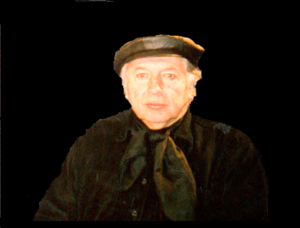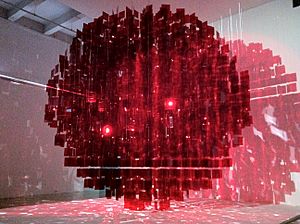Julio Le Parc facts for kids
Quick facts for kids
Julio Le Parc
|
|
|---|---|
 |
|
| Born | September 23, 1928 Mendoza, Argentina
|
| Education | School of Fine Arts |
| Movement | Groupe de Recherche d'Art Visuel (GRAV) |
Julio Le Parc (born September 23, 1928) is an artist from Argentina. He is famous for his modern art, especially op art and kinetic art. Op art uses optical illusions to make you think things are moving or changing. Kinetic art actually moves or has parts that move.
Le Parc went to the School of Fine Arts in Argentina. He helped start a famous art group called Groupe de Recherche d’Art Visuel (GRAV). He has won many awards and is a very important artist in Argentina. He received the Konex Award from Argentina in 1982 and again in 2022.
Contents
About Julio Le Parc's Life
Julio Le Parc grew up in a family that didn't have much money. When he was thirteen, he moved with his mother and brothers to Buenos Aires. He went to the School of Fine Arts there. He became very interested in new and experimental art movements in Argentina.
Le Parc is a pioneer of Kinetic Art and Op Art. He was a founding member of the Groupe de Recherche d’Art Visuel. In 1966, he won the Grand Prize for Painting at the 33rd Venice Biennale. This made him a major figure in modern art history. Le Parc was also an artist who cared deeply about society. He stood up for human rights. He currently lives and works in Cachan, France.
Julio Le Parc's Art Career
Starting His Art Journey
Julio Le Parc found his interest in art when he was thirteen. He was not a great student in other subjects. But he was amazing at drawing portraits and illustration cards. The School of Fine Arts greatly influenced his early career. He took night classes while working full-time.
Le Parc was very interested in new art movements in Argentina. One of these was the Movement of Arte Concreto Invencion. After four and a half years, he left the school and traveled the country. He didn't speak to his family for eight years. Later, he returned to the Academy of Fine Arts. There, he became active in student art groups. Julio Le Parc graduated from the Academy of Fine Arts with Luis Wells and Rogelio Polesello.
In 1958, Le Parc received a grant to go to Paris, France. This was from the French Cultural Service. Early in his career, he focused on painting and engraving. However, in 1959, Le Parc began to experiment. He started creating images using light. He multiplied light with layers of Plexiglas. Le Parc had his first exhibition in 1957. It was at the Bienal de Sáo Paulo in Brazil.
Developing His Unique Style
When Le Parc arrived in Paris in 1958, he met other artists. These included Jesús Rafael Soto and Carlos Cruz-Diez. They also became friends with Victor Vasarely, Georges Vantongerloo, Morellet, and Denise René. René was a French art dealer. She helped promote abstract art and kinetic art.
After moving to Paris, Le Parc started painting "Surfaces Sequences." These artworks show forms that change slightly. This creates an illusion of rhythmic movement. In 1960, the GRAV group was formed. Their goal was to let the viewer be part of the creative act. The group wanted art to have a bigger role in society.
In 1966, Le Parc won the Grand Prize in Painting. This was at the 33rd Biennale di Venezia in Venice. He had been living in Paris for eight years. By this time, Le Parc was deeply involved in light experiments. He explored how light and moving parts could create new experiences. He experimented with light projected on walls, ceilings, and floors. He also used light on reflecting cylinders.
Le Parc was a strong supporter of human rights. He spoke out against unfair governments in Latin America. In 1972, he decided not to have a big art show. This was at the Musée d'Art Moderne de la Ville de Paris.
Later Works and Recognition
Le Parc has continued to use light and movement in his art. For some time, his work was not as widely known. However, there is now a new interest in his art. His work is being seen by more people around the world.
In 2004, he created a series of sculptures called "Torsions." He worked with Yvonne Argenterio in Italy. These sculptures were shown at an event called "Verso la Luce." A large sculpture from this series is still in the castle garden there.
In 2013, he had a special show just for his work. It was at the Palais de Tokyo in Paris. Le Parc is also interested in immersive art. This type of art makes you feel like you are inside the artwork.
Selected Artworks by Julio Le Parc
Mobil Transparent theme, 1960
Mobil Transparent theme is made of small pieces of Plexiglas. They are connected like a clear waterfall. It hangs from the ceiling. This artwork was a highlight of his 2011 exhibition in Miami, Florida. It was placed in the center of the main room. Viewers could walk around it. They could see different reflections on a mirror below it. Le Parc made a new version of this 1960 work for the Miami show.
Light in Movement, 1962
Light in Movement is another artwork that focuses on your senses. Like all of Le Parc's works, it tells no story. Instead, it is meant to be experienced. The piece uses painted drywall, mirrors, and spotlights. It is about 42 feet long and 16 feet wide and tall. This artwork is in a dark, curved hallway. Light is seen as both reflections and refractions. Viewers stand below the work. They watch many twinkling lights all around the space. This piece was also remade in 2010 for an installation. Le Parc and the GRAV group wanted viewers to interact with their art.
Celule Avec Luminere un Vibration, 1968
This piece was also part of the Miami exhibition in 2011. Celule Avec Luminere un Vibration uses light to create a sensory experience. This artwork is from 1968. It is about 150 x 157 x 137 inches. A projector shines light on a wall. The light changes patterns in a rhythmic way. It looks like a vibration. This piece was in its own room. This helped viewers feel isolated and enjoy the light and sound.
Alchemy 175 and 216, 1991-92
The Alchemy series is a key part of Le Parc's work. He showed two paintings from this series in Miami in 2011. These were Alchemy 175 and Alchemy 216. The paintings are named "Alchemy" followed by a number. The number shows the order they were made. Alchemy 175 is from 1991, and Alchemy 216 is from 1992. These pieces are Le Parc's tribute to the idea of alchemy. They explore the importance of water. Water is seen as one of nature's main elements. It symbolizes change, renewal, and cleansing. Le Parc explores movement in these paintings. He paints fountains sprinkling water in an umbrella shape. He uses light to change how the viewer sees them.
Modulation 1160, 2004
The Modulation series is another important group of works by Le Parc. He has been working on it since the early 1970s. Like the Alchemy series, these works are named "Modulation" followed by a number. Modulation 1160 is from 2004. Many people think it is one of the best works in the series. The painting is divided into four parts. A ray of light seems to split it down the middle. A structure like an open fan crosses it side to side. The work is acrylic on canvas. It measures about 39.5 x 39.5 inches. This painting creates the illusion of movement. Both the light and the fan seem to be moving at the same time. It looks like the light is making the fan move. The Modulation series has hundreds of different works. Le Parc calls them experiments.
Other Notable Artworks
- Images projetées, 1962
- Sol instable, 1964/2005
- Rubans au vent, 1988
- Lumière sur mât, 1999
Exhibitions Featuring Julio Le Parc
Solo Exhibitions
- Perez Art Museum Miami (PAMM), Miami, Florida, USA, 2016
- Serpentine Sackler Gallery, London, United Kingdom, 2014–2015
- Palais de Tokyo, Paris, France, 2013
- Otra Mirada, Buenos Aires, Argentina, 2010
- Le Parc. Lumière. La Habana, Cuba, 2009
- Julio Le Parc et Vertige Vertical. Cachan, France, 2005
- Julio Le Parc - Verso la Luce - TORSIONS, permanent sculpture in Boldeniga-Brescia, Italy, 2004
- Alquimias. Quito, Ecuador, 1998
- Salle de jeux et travaux de surface. Arcueil, France, 1996
- Obra reciente. Valencia, Spain, 1991
- Modulazioni di Julio Le Parc. Brescia, Italy, 1988
- Galleria La Polena, Genova, Italy, 1979
- Galerie Denise René, New York, New York, USA, 1973
- Kinetische Objekte. Ulm, Germany, 1970
Group Exhibitions
- Flash! Light and Movement. Tampere, Finland, 2009
- 50 años de pintura geométrica latino-americana. La Plata, Argentina, 2002
- Portes ouvertes. Cachan, France, 1994
- I Bienal de Cuenca. Cuenca, Ecuador, 1987
- Arte Programmata e Cinetica 1953-1963. Milano, Italy, 1983
- Brigade International de Peintres Antifascistes. Athens, Greece, 1975
- Kinetics. London, UK, 1970
- Light in Orbit. New York, New York, USA, 1967
- Groupe de Recherche d'Art Visuel. Paris, France, 1960
- IV Bienal de São Paulo. São Paulo, Brazil, 1957
See also
 In Spanish: Julio Le Parc para niños
In Spanish: Julio Le Parc para niños


